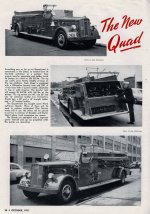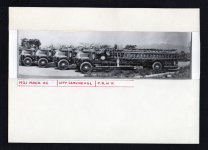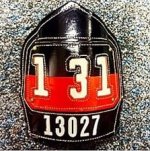- Joined
- Aug 16, 2008
- Messages
- 1,174
I’m still kinda surprised that 70/53 don’t have second due areas since the bridge no longer rises.
Unfortunately you are probably right.When the money gets tight sooner or later all cost saving plans will be on the table. Quints might be one of those, probably starting in the same companies that were CFC's in the '70s.
I would be willing to bet that will never happen! Quints!Unfortunately you are probably right.
FDNY did not have Quints, but they had Quads.A quint in City Island? Do you mean when they strapped a ground ladder over the hose bed to fool the local citizenry? Not sure the FDNY ever had any quints in front line service.














While I agree that some cities have started using Quints others have gone away from them. St. Louis at one time was all quints but recently they have started going away from them back to traditional engine and truck companies. They found out that Quints didn't work. Quints may be all right for smaller departments but for larger departments they are not that great!In addition, these days Quints have been put to use in other cities, including some of our larger city and county departments.
Earlier in this thread I had mentioned about Milford, Ct, a small city with an ISO Class 1 rating (the best a city could get). I saw Milford change from Two ladder trucks to One. They did that by making Two Engine Companies into Quints. Those Quints run as regular Engine Companies and each has their own first due response area. BUT in addition to that, they ARE used as a second Ladder Company when needed.
I'm NOT saying I'm in favor of putting Quints into service to replace both an Engine Company and a Ladder Company. But "I am saying that it has been done and city's have reason to consider it these days with money being short in some places".
Let me also add this as another thought. Recently here in Norwich, Ct the city hired the McGrath Fire Consulting firm to make recommendations to changes in the Fire Service here. One of the things in the 200 page report was that they recommended eliminating Engine 3, (officer/2 firefighters) and replace that company with a "SUV type", Medical Response Vehicle because of the increase number of medical responses, while the number of building fires are down. Engine 3 is housed at the same firehouse with "Squad A, a Rescue/Pumper", plus a Ladder Co. That consulting group felt the firehouse does NOT need Two Engine Companies.
Quints would have found their way into FDNY if they were feasible in NYC. They would not be good options for CFCs of the 1970s which at least had both engine and ladder apparatus. Would a Quint at Engine 151 be able to replace both Engine 151 and Ladder 76 - no. Although a nice concept for many departments, there are some problems that make Quints not a viable option in most big cities.When the money gets tight sooner or later all cost saving plans will be on the table. Quints might be one of those, probably starting in the same companies that were CFC's in the '70s.
I certainly agree with most of these disadvantages you posted but Quints are also available with a 100' ladder on them.
- Perfect positioning needed. The 75-foot ladder has come up short when perfect positioning at the fire scene is not possible.
I work for a small suburb dept outside of Cleveland OH. We run a 100’ mid mount quint as a truck. It does not act like an engine anywhere, it’s more of an “oh crap, we need a line and we’re in this truck not an engine” type of deal. We’re running with 5 guys on duty at a time, so it’s strictly a manpower thing for us.I certainly agree with most of these disadvantages you posted but Quints are also available with a 100' ladder on them.
There are also obviously some advantages to them. One of the biggest being if they are 1st due they are going to be located in front of the structure in most cases so if they go to work as a ladder company their apparatus will be ideally located. Sometimes ladder companies have a hard time getting into a good location when a 1st due engine company is directly in front of the building. Obviously there are also some other advantages are also many departments wouldn't be using them. I do agree with you however that they are not a great choice for larger departments in most cases.
FDNY did not have Quints but it has had combined engine-truck companies for long periods of time.
FDNY had "combined engine companies". Combination engine companies were organized in the early days of the department, primarily in outlaying areas. Existing engine and truck companies were reorganized, or new companies were organized as "Combination Engine Companies". They had both a pumper (or steamer) and a ladder apparatus. This practice continues as FDNY expanded into Brooklyn and the Bronx. Combined Engine Companies operated in NYC well into the 1950s (e.g. Combination Engine 96 - 1951).
Brooklyn Combined Engine Company 144"s (became 244) used this City Service H&L apparatus along with its assigned pumper.
View attachment 14423
In the picture above , where was Combo 131. The picture shows TL-131 operating in Brooklyn, they were never a Combo house. Interesting to see those black boxes that carried the masks, had to be early 70’s.
Isolated City Island (later Welfare Island and then Roosevelt Island) was assigned Combined Engine 49 in 1882 before being disbanded when a bridge to Queens was built in 1958.
View attachment 14424
Combined Fire Companies - 1970s. To save money during a budget shortage, FDNY combined some engine and truck companies located in the same firehouses in outlaying areas. A captain supervised both an engine section and a truck section - to save the city money. Only 1 officer was assigned per shift, so the firehouse had 4 captains instead of 2 captains and 6 lieutenants assigned.
The companies were called "Combined Fire Companies" and always responded with both sections. There were no advantages - except saving a few salaries. There were many disadvantages. Supervision and control were significantly decreased operationally and administratively. Unnecessary resources were assigned to minor incidents because the engine section or the truck section could not respond independently. Relocations were a problem. Assignments on multiple alarms were a problem. Training was a problem. Details were more difficult.
View attachment 14416
View attachment 14417
View attachment 14414
View attachment 14415
View attachment 14418
View attachment 14419
70/53 have to travel over two miles before they even reach another company's first due area. Adjacent company second dues are all closer.I’m still kinda surprised that 70/53 don’t have second due areas since the bridge no longer rises.
Let me also add this as another thought. "recommended eliminating Engine 3, (officer/2 firefighters) and replace that company with a "SUV type", Medical Response Vehicle because of the increase number of medical responses, while the number of building fires are down. Engine 3 is housed at the same firehouse with "Squad A, a Rescue/Pumper", plus a Ladder Co.
The original combination fire companies were three piece companies – steamer, hose wagon, and ladder truck. They were implemented as the initial career fire protection in developing residential neighborhoods previously served by volunteer companies. As the fire challenges grew with higher density, multi-story construction and commercial occupancies, the combination companies were replaced by separate engine and ladder companies.FDNY had "combined engine companies". Combination engine companies were organized in the early days of the department, primarily in outlaying areas. Existing engine and truck companies were reorganized, or new companies were organized as "Combination Engine Companies". They had both a pumper (or steamer) and a ladder apparatus. This practice continues as FDNY expanded into Brooklyn and the Bronx. Combined Engine Companies operated in NYC well into the 1950s (e.g. Combination Engine 96 - 1951).
Quints are all function, generic apparatus, with all purpose capabilities, but generally with staffing for one major function at a time. In addition to the many limitations of the apparatus, intensive training is desirable to have a fully adaptable crew for any potential task under short staff conditions.I certainly agree with most of these disadvantages you posted but Quints are also available with a 100' ladder on them.
There are also obviously some advantages to them. One of the biggest being if they are 1st due they are going to be located in front of the structure in most cases so if they go to work as a ladder company their apparatus will be ideally located. Sometimes ladder companies have a hard time getting into a good location when a 1st due engine company is directly in front of the building. Obviously there are also some other advantages are also many departments wouldn't be using them. I do agree with you however that they are not a great choice for larger departments in most cases.
